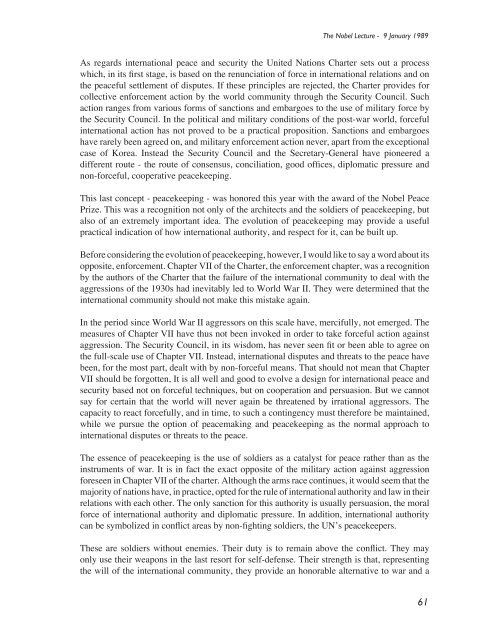Defence Forces Review 2008
Defence Forces Review 2008
Defence Forces Review 2008
Create successful ePaper yourself
Turn your PDF publications into a flip-book with our unique Google optimized e-Paper software.
The Nobel Lecture - 9 January 1989<br />
As regards international peace and security the United Nations Charter sets out a process<br />
which, in its first stage, is based on the renunciation of force in international relations and on<br />
the peaceful settlement of disputes. If these principles are rejected, the Charter provides for<br />
collective enforcement action by the world community through the Security Council. Such<br />
action ranges from various forms of sanctions and embargoes to the use of military force by<br />
the Security Council. In the political and military conditions of the post-war world, forceful<br />
international action has not proved to be a practical proposition. Sanctions and embargoes<br />
have rarely been agreed on, and military enforcement action never, apart from the exceptional<br />
case of Korea. Instead the Security Council and the Secretary-General have pioneered a<br />
different route - the route of consensus, conciliation, good offices, diplomatic pressure and<br />
non-forceful, cooperative peacekeeping.<br />
This last concept - peacekeeping - was honored this year with the award of the Nobel Peace<br />
Prize. This was a recognition not only of the architects and the soldiers of peacekeeping, but<br />
also of an extremely important idea. The evolution of peacekeeping may provide a useful<br />
practical indication of how international authority, and respect for it, can be built up.<br />
Before considering the evolution of peacekeeping, however, I would like to say a word about its<br />
opposite, enforcement. Chapter VII of the Charter, the enforcement chapter, was a recognition<br />
by the authors of the Charter that the failure of the international community to deal with the<br />
aggressions of the 1930s had inevitably led to World War II. They were determined that the<br />
international community should not make this mistake again.<br />
In the period since World War II aggressors on this scale have, mercifully, not emerged. The<br />
measures of Chapter VII have thus not been invoked in order to take forceful action against<br />
aggression. The Security Council, in its wisdom, has never seen fit or been able to agree on<br />
the full-scale use of Chapter VII. Instead, international disputes and threats to the peace have<br />
been, for the most part, dealt with by non-forceful means. That should not mean that Chapter<br />
VII should be forgotten, It is all well and good to evolve a design for international peace and<br />
security based not on forceful techniques, but on cooperation and persuasion. But we cannot<br />
say for certain that the world will never again be threatened by irrational aggressors. The<br />
capacity to react forcefully, and in time, to such a contingency must therefore be maintained,<br />
while we pursue the option of peacemaking and peacekeeping as the normal approach to<br />
international disputes or threats to the peace.<br />
The essence of peacekeeping is the use of soldiers as a catalyst for peace rather than as the<br />
instruments of war. It is in fact the exact opposite of the military action against aggression<br />
foreseen in Chapter VII of the charter. Although the arms race continues, it would seem that the<br />
majority of nations have, in practice, opted for the rule of international authority and law in their<br />
relations with each other. The only sanction for this authority is usually persuasion, the moral<br />
force of international authority and diplomatic pressure. In addition, international authority<br />
can be symbolized in conflict areas by non-fighting soldiers, the UN’s peacekeepers.<br />
These are soldiers without enemies. Their duty is to remain above the conflict. They may<br />
only use their weapons in the last resort for self-defense. Their strength is that, representing<br />
the will of the international community, they provide an honorable alternative to war and a<br />
61
















